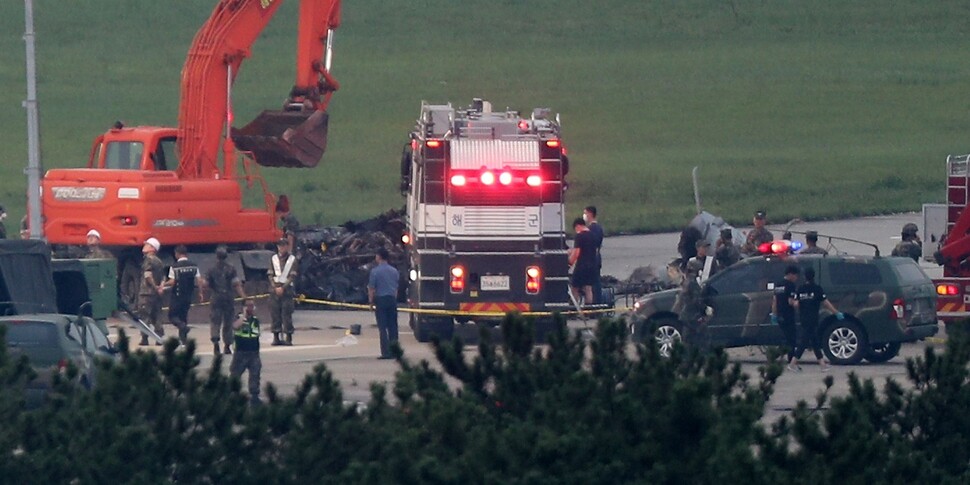hankyoreh
Links to other country sites 다른 나라 사이트 링크
Crashed helicopter was modeled on seriously defective Surion model

The Marineon (MUH-1) amphibious utility helicopter that crashed on July 17 was modeled after the cutting-edge Surion (KUH-1), South Korea’s first homegrown helicopter that cost more than 1 trillion won (US$885.68 million) to develop. The Marineon had been adapted for the purposes of the ROK Marine Corps.
Developing a domestic amphibious utility helicopter had long been a pet project of the South Korean military. Until the Marineon came into service in January, South Korea’s marines had relied on the US amphibious helicopters used in joint operations. On Jan. 10, the marines acquired Marineon 1 and Marineon 2, the latter of which was reportedly the helicopter that crashed.
The marines had hoped that introducing the Marineon would enhance the mobility and radius of their independent amphibious operations. At the time, ROK Marine Corps Commander Lt. Gen. Chun Jin- proudly said that “the marines have got their wings back.” But the “wings” of the Marine Corps will be remembered as the helicopter in which five service members lost their lives just six months after it entered service.
“We run test flights when there’s going to be a long flight or when there’s an equipment defect. And even if there’s no particular problem, we conduct repairs and do test flights to ensure that nothing is wrong,” said an official with the Marine Corps when asked about the reason for the test flight when the accident occurred.
“Helicopter crashes can be caused by an engine malfunction, among other things, but we’ll have to review the flight recorder in order to know for sure what caused the accident,” the official said.
The pilot who died in the accident was reportedly a veteran who had graduated from test flight school in the US and logged more than 3,330 flight hours.
In an audit published in July 2017, the Board of Audit and Inspection said that the domestic utility helicopter Surion had flaws in its fuselage and engine that had caused a string of accidents. This raises questions about whether the Marineon – which was based on the Surion and adapted for maritime use – is affected by the same defects.
“My understanding is that the Surion defect issue has been resolved,” said an official with the marines.
The Marineon – the name is a portmanteau of “marine” and “Surion,” – is 19m long, 5m high and 3.5m wide, with a maximum cruising speed of 265kph. The helicopter can carry up to nine people and is armed with two 7.62mm machine guns. The Marineon is optimized for shipborne and maritime operations, with long-range wireless communications equipment, a tactical air navigation system (TACAN) and an extra fuel tank. The helicopter was also equipped with folding landing gear to aid shipborne operations and a flame-retardant apparatus on the fuselage to prevent fires.
Korea Aerospace Industries developed the Surion, a multipurpose utility helicopter that cost 1.3 trillion won (US$1.15 billion), between 2006 and 2012 with the purpose of replacing the army’s aging helicopters. Then between 2013 and 2016, Korea Aerospace Industries developed the Marineon, a utility helicopter modeled on the Surion, along with medical evacuation helicopters, aerial firefighting helicopters, and helicopters for the National Police Agency and the Korea Forest Service.
This was the first time that a Surion helicopter or related model has had a fatal crash in South Korea. Last year, there was one helicopter crash in South Korea in which the pilot died, along with three in 2016, one in 2015, one in 2014, two in 2013, one in 2012, three in 2011 and one in 2010.
By Kim Il-woo, Daegu correspondent, and Noh Ji-won, staff reporter
Please direct comments or questions to [english@hani.co.kr]

Editorial・opinion
![[Column] Has Korea, too, crossed the Rubicon on China? [Column] Has Korea, too, crossed the Rubicon on China?](https://flexible.img.hani.co.kr/flexible/normal/500/300/imgdb/original/2024/0419/9317135153409185.jpg) [Column] Has Korea, too, crossed the Rubicon on China?
[Column] Has Korea, too, crossed the Rubicon on China?![[Correspondent’s column] In Japan’s alliance with US, echoes of its past alliances with UK [Correspondent’s column] In Japan’s alliance with US, echoes of its past alliances with UK](https://flexible.img.hani.co.kr/flexible/normal/500/300/imgdb/original/2024/0419/2317135166563519.jpg) [Correspondent’s column] In Japan’s alliance with US, echoes of its past alliances with UK
[Correspondent’s column] In Japan’s alliance with US, echoes of its past alliances with UK- [Editorial] Does Yoon think the Korean public is wrong?
- [Editorial] As it bolsters its alliance with US, Japan must be accountable for past
- [Guest essay] Amending the Constitution is Yoon’s key to leaving office in public’s good graces
- [Editorial] 10 years on, lessons of Sewol tragedy must never be forgotten
- [Column] A death blow to Korea’s prosecutor politics
- [Correspondent’s column] The US and the end of Japanese pacifism
- [Guest essay] How Korea turned its trainee doctors into monsters
- [Guest essay] As someone who helped forge Seoul-Moscow ties, their status today troubles me
Most viewed articles
- 1[Column] The clock is ticking for Korea’s first lady
- 2After 2 months of delayed, denied medical care, Koreans worry worst may be yet to come
- 3Samsung barricades office as unionized workers strike for better conditions
- 4[Column] Has Korea, too, crossed the Rubicon on China?
- 5[Correspondent’s column] In Japan’s alliance with US, echoes of its past alliances with UK
- 6Hong Se-hwa, voice for tolerance whose memoir of exile touched a chord, dies at 76
- 7All eyes on Xiaomi after it pulls off EV that Apple couldn’t
- 8US overtakes China as Korea’s top export market, prompting trade sanction jitters
- 9[Editorial] When the choice is kids or career, Korea will never overcome birth rate woes
- 10[Photo] Smile ambassador, you’re on camera